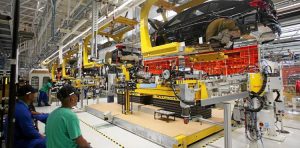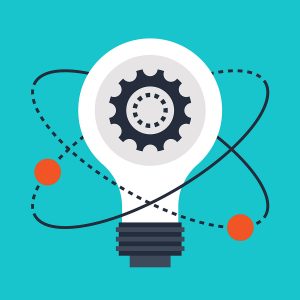No enterprise wants to be a dinosaur when it comes to innovation, and today, AI is on the cutting edge. With an estimated 80 percent of enterprises already using AI in some form, the transition to AI seems as widespread as the transition from typewriters to PCs.
Despite the hype, enterprises ‘sense’ the challenge: in a recent study, 91 percent of companies foresee significant barriers to AI adoption, including a lack of IT infrastructure, and shortage of AI experts to guide the transition.
(article originally appeared on Manufacturing Business Technology)
Still, few organizations truly understand what lies ahead of them, and what it really takes to transition out of the AI Jurassic era. Let’s look more closely at the underlying realities of AI adoption that your internal AI group or consultant will never tell you.
The Use Case: Turning a Traditional Enterprise Into an AI-Enabled Organization
To paint a picture, let’s consider a hypothetical company, Global Heavy Industry Corporation (GHIC). Perhaps their goal is to reduce costs and improve quality in its production facilities via a corporate-wide deployment of AI.
 The company manufactures industrial machinery that requires skilled workers to assemble complex machinery from parts, and has a series of control checkpoints to maintain production quality. Currently, the process is completely manual.
The company manufactures industrial machinery that requires skilled workers to assemble complex machinery from parts, and has a series of control checkpoints to maintain production quality. Currently, the process is completely manual.
With the recent raise in AI awareness, coupled with competitive pressures from lower-cost producers, GHIC has set forth an aggressive roadmap of introducing visual-based AI in their factories, by leveraging existing security camera infrastructures.
The first step? Collecting pertinent data for their models.
Myth No. 1: All the Data I Need for My AI Is Freely Available
The first hurdle GHIC faces is gathering and preparing data for their visual AI. Data is AI’s DNA: neural networks and deep learning architectures rely on deriving a function to map input data to output data.
 The effectiveness of this mapping function hinges on both the quality and quantity of the data provided. In general, having a larger training set has been proven to enable more effective features in the network, leading to better performance. In short, large quantities of high-quality data lead to better AI.
The effectiveness of this mapping function hinges on both the quality and quantity of the data provided. In general, having a larger training set has been proven to enable more effective features in the network, leading to better performance. In short, large quantities of high-quality data lead to better AI.
But how do companies go about producing and preparing this data? Amassing and labeling (or annotating) is usually the most time-consuming and expensive step in data preparation. This process enables a system to recognize categories or objects of interest in data, and defines the appropriate outcome the algorithm should predict once deployed.
Oftentimes, internal annotation is the only option for enterprises, due to privacy or quality concerns. This might be because data can’t leave the facility or needs extremely accurate tagging from an expert.
GHIC realizes that collecting and labeling data on site, in the relevant environment, is the first necessary step for building a prototype and a working system. Hundreds of hours of videos need to be collected and labeled, as well as thousands of images containing healthy/defective parts, and quality control experts know the difference between a normal variation in production quality and a problem. So, tackling data becomes a challenge. One way to combat this challenge would be to enable GHIC’s AI to learn continuously, significantly reducing data and training time needed, and enabling real-time learning and improvement of the AI.
Myth No. 2: I Can Easily Hire AI Experts to Build an Internal AI Solution
Once the data is prepared and ready, the second task is to build the initial implementation of the AI system. This is where the next set of challenges lies for GHIC. While there are a plethora of AI tools for developers, AI expertise is hard to find. By some estimates, there are only around 300,000 AI experts worldwide (22K PhD qualified).
 Undoubtedly, the need for AI talent outweighs the demand. While the option of accelerating training in AI is unfeasible—it still takes four years to earn a Ph.D.—the only viable option is to lower the bar to entry, by introducing software frameworks that sidestep the need for in-depth knowledge of the field. Otherwise, organizations risk waiting forever to find adequate AI talent.
Undoubtedly, the need for AI talent outweighs the demand. While the option of accelerating training in AI is unfeasible—it still takes four years to earn a Ph.D.—the only viable option is to lower the bar to entry, by introducing software frameworks that sidestep the need for in-depth knowledge of the field. Otherwise, organizations risk waiting forever to find adequate AI talent.
Myth No. 3: I Have a PoC, Building a Final AI Solution Is Just ‘a Bit More Work’
If GHIC gets to the point of finding the internal/external AI resources to implement a Proof of Concept (PoC), they may assume that they’re only steps away from deploying a final solution.
 In reality, AI adoption requires a multi-step approach. For many organizations, the first step is a PoC. After many years of working in AI, I have seen countless PoCs fall short of implementation. To avoid wasted time and money, organizations need to set a timeline, and define criteria in advance that will decide whether the tech should go into production. A simple benchmark such as “if the PoC delivers X at Y functionality, then we’ll launch it here and here” would go a long way to help enterprises define an actual deployment scenario.
In reality, AI adoption requires a multi-step approach. For many organizations, the first step is a PoC. After many years of working in AI, I have seen countless PoCs fall short of implementation. To avoid wasted time and money, organizations need to set a timeline, and define criteria in advance that will decide whether the tech should go into production. A simple benchmark such as “if the PoC delivers X at Y functionality, then we’ll launch it here and here” would go a long way to help enterprises define an actual deployment scenario.
Myth No. 4: When I Get a Good Performance From My AI, I Don’t Need to Touch It Anymore
Let’s assume GHIC gets past all the hurdles above, and successfully implements AI. Over time, GHIC will be challenged by continuously emerging use cases or changing conditions, and the need to adapt their AI in a timely and inexpensive fashion.
 Successful organizations look beyond today, to ask how their AI solution can scale over time. With AI systems of greater complexities, data storage/management, retraining costs/time, and overall AI lifecycle management tools are required to make sure an AI project does not become a mess, or worse, ineffective.
Successful organizations look beyond today, to ask how their AI solution can scale over time. With AI systems of greater complexities, data storage/management, retraining costs/time, and overall AI lifecycle management tools are required to make sure an AI project does not become a mess, or worse, ineffective.
Beyond AI Myths: AI Is Not a One-Off, It Is Here to Stay
GHIC has learned the hard way that AI is not a simple, one-off project. On the contrary, it can turn into a long, costly endeavor.
To effectively implement AI, enterprises will need to develop internal teams mixing engineering, R&D and product, that work closely in building, testing, and delivering the application, and will oversee maintaining and iterating on it in the future.
And new tools are enabling more and more organizations to take on AI adoption. By taking back control of their AI strategy, enterprises’ teams will be able to quickly build AI solutions, deploy and grow them over the AI lifecycle.
Max Versace is CEO and co-founder of Neurala.

